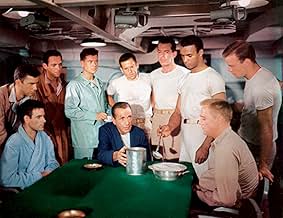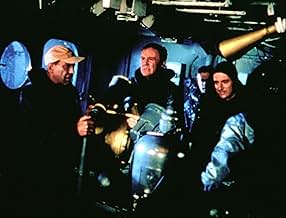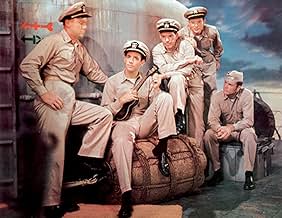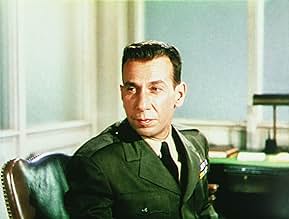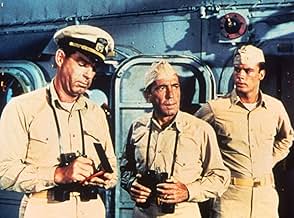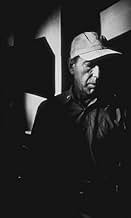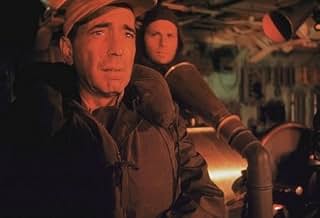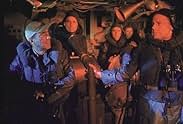Als ein Kapitän der US-Marine Anzeichen von geistiger Instabilität zeigt, die das Schiff gefährden, enthebt ihn der erste Offizier des Kommandos und stellt ihn wegen Meuterei vor ein Kriegsg... Alles lesenAls ein Kapitän der US-Marine Anzeichen von geistiger Instabilität zeigt, die das Schiff gefährden, enthebt ihn der erste Offizier des Kommandos und stellt ihn wegen Meuterei vor ein Kriegsgericht.Als ein Kapitän der US-Marine Anzeichen von geistiger Instabilität zeigt, die das Schiff gefährden, enthebt ihn der erste Offizier des Kommandos und stellt ihn wegen Meuterei vor ein Kriegsgericht.
- Regie
- Drehbuch
- Hauptbesetzung
- Für 7 Oscars nominiert
- 2 Gewinne & 13 Nominierungen insgesamt
- Lt. Barney Greenwald
- (as Jose Ferrer)
- Lt. Tom Keefer
- (as Fred Mac Murray)
- Mrs. Keith
- (as Katharine Warren)
- Engstrand
- (Nicht genannt)
- Radarman
- (Nicht genannt)
- Ens. Rabbit
- (Nicht genannt)
Empfohlene Bewertungen
This over-the-top film contains interesting drama , a maritime intrigue , spectacular taking on among crew officers and being beautifully realized . Impressive scenes when happens a storm with a well made ship to scale model . Good performances by all-star-cast as Van Johnson , Fred MacMurray , Jose Ferrer and of course Humphrey Bogart's tour-de-force performance in the climactic courtroom scene was so powerful that it completely captivated the onlooking film technicians and crewmen . After the scene's completion, the company gave Bogart a round of thunderous applause . Besides , an excellent plethora of secondary actors : E.G. Marshall , Claude Akins , Whit Bissell , Edward Franz , Warner Anderson , James Best and Lee Marvin . Interesting screenplay by Stanley Roberts based on the prestigious novel from Herman Wouk who won Pulitzer Prize . Evocative and appropriate music score by the classic Max Steiner with perdurable leitmotif . Colorful cinematography in marvelous Technicolor by Franz Planer .
The motion picture is stunningly directed by Edward Dmytryck , he was a craftsman whose career was interrupted by the activities of the House Un-American Activities Committee (HUAC), a congressional committee that employed ruthless tactics aimed at rooting out and destroying what it saw as Communist influence in Hollywood . A lifelong political leftist who had been a Communist Party member briefly during World War II, Dmytryk was one of the so-called "Hollywood Ten" who refused to cooperate with HUAC and had their careers disrupted or ruined as a result. The committee threw him in prison for refusing to cooperate, and after having spent several months behind bars , Dmytryk decided to cooperate . Dmytrick's biggest film was ¨The Caine Mutiny¨ , but he also realized another mutiny film titled : ¨Mutiny¨ with Angela Lansbury , Mark Stevens and Patrick Knowles . Edward was an expert on warlike genre as ¨Back to Batan¨ , ¨Battle of Anzio¨ , ¨Young lions¨ and Western as ¨Broken lance¨ , ¨Alvarez Kelly¨ , ¨Warlock¨ among others. Rating : a complete must see , it's recommended for courtroom drama enthusiasts and Bogart fans . Followed by a full-length adaptation, THE CAINE MUTINY COURT-MARTIAL (TV,1988) originally staged as a play , of the court-martial segment from the novel "The Caine Mutiny" by Robert Altman with Brad Davis , Eric Bogosian , Peter Gallaher , Kevin J O'Connor , Jeff Daniels and Michael Murphy .
But the best known mutiny in the American navy is that on the U.S.S. Caine, during the hurricane that preceded the battle of Okinawa. That this is a fictional mutiny does not seem to attract any attention. THE CAINE MUTINY was a successful novel, Broadway play ("THE CAINE MUTINY COURT MARTIAL") and a great movie. It remains the American equivalent of the mutiny on the H.M.S. Bounty.
The performances of the leads, Bogart, Johnson, MacMurray (his second of three great heels), Ferrer, Tully, and E.G.Marshall are all first rate, as are the supporting cast (which includes Lee Marvin, Claude Atkins, and Jerry Paris - all of whom had quite substantial careers after this film). Only Robert Francis did not have a substantial career after his fine Ensign Keith - he died in a plane crash in 1955.
There are mental images from the film (mostly connected to Bogart's Queeg) that people remember - even spoof. Every time you see some character showing nervous ticks, if he or she pulls out a pair of small metal balls and roll them in their hand, it is a salute to Bogie's originally doing it in THE CAINE MUTINY. And his magnificent moment of success: "the strawberries", and how he proved the theft with geometric precision, remains a signal that the person speaking has too many fixations.
Interestingly, the film makes Queeg better (if still sick) than the play does. When cross examined by Greenwald at the court martial of Maryk and Keith, Queeg is asked about whether or not he overused his right to free transport of liquor and other items from Hawaii to the mainland from the navy. Queeg at first denies it, but when Greenwald says he can bring in (as witnesses) people connected with the sale of the items and the transport of them, Queeg suddenly remembers that he might have. This is not in the film, but it shows that Queeg was not all that clean an officer.
That aside, the impact of the film is still terrific half a century after it was shot. It illustrates that personality flaws frequently causes the problems that affect all of us, and that we need more understanding of each other's problems to avoid the bigger ones. From a case of over-extended battle fatigue, the crew of a warship are driven to accept an act of mutiny against it's captain in an emergency situation. And it almost gets two officers disgraced or hanged.
The movie takes place on a destroyer-minesweeper in the Pacific during World War II. To the consternation of the Caine's crew, a popular captain (Tom Tully) is replaced by a disturbed despot named Queeg (Humphrey Bogart), who finds himself in over his head. As the stresses of command multiply, Queeg's paranoia and cowardice soon become apparent to Lieutenant Thomas Keefer (Fred MacMurray), a writer in civilian life. Keefer continually tries to convince Executive Officer Steve Maryk (Van Johnson) that Queeg is insane, but Keefer won't help Maryk when the Exec asks Keefer to help convince higher authority that Queeg should be relieved. During a typhoon, Queeg's poor seamanship nearly capsizes the Caine; Maryk relieves him by reason of insanity and saves the ship. Maryk and Willie Keith (Robert Francis), Officer of the Deck when Queeg is relieved, stand trial for mutiny. They are reluctantly defended by Lt Barney Greenwald (Jose Ferrer), who must expose Queeg's mental illness to save the defendants. In so doing Greenwald forces the Caine's officers to examine their own motives regarding their roles in Queeg's relief and their lack of loyalty to him.
Bogart is brilliant, giving the greatest performance of his career, his quirky mannerisms and tortured demeanor contrasting starkly with his usual roles. MacMurray is superb as the glib slippery novelist who must eventually deal with his own cowardice, more damning than Queeg's because of his intelligence and insight. Johnson plays Maryk more timidly than he appears in the book, to the detriment of the movie. Ferrer gives a solid performance. Tully excels as the crusty Capt DeVriess, Queeg's predecessor.
The weakest part of Wouk's book is the largely irrelevant romance between Willie Keith and a nightclub singer of whom his wealthy mother disapproves. Unhappily this vapid subplot finds its way into the movie, serving only to reveal Francis and his love interest May Wynn as lousy actors whose mercifully brief cinematic careers were well deserved. Important character developments in the novel could have been included instead of this unnecessary pap.
Despite its flaws, The Caine Mutiny is a must see for serious movie fans. Bogart and MacMurray give performances which remain fresh and compelling with every viewing of the film. You can't ask more from an actor than that.
A subplot, seeming to lack common sense, between two young lovers (Robert Francis and May Wynn) only served to lessen the concentration and distract our attention from the real story Also, at the court-martial, a long trial sequence, was clearly anticlimactic, though it included the film's most tense and unforgettable scene, that of Queeg disintegrating as he pronounced his statement
But we had noticed it all before, after all, aboard the Navy destroyer, the U.S.S. Caine We had seen Queeg as a strict disciplinarian and a compulsive, unstable commander, earning, in his limited imagination, the total disregard of both officers and crew So we knew what would occur when he got on the witness stand
"The Caine Mutiny" is a splendid character study, a tale of bravery and cowardice at odds with one another The film received seven Academy Award nominations included one to Humphrey Bogart who delivered a terrific performance
One of Bogies finest performances.
Wusstest du schon
- WissenswertesThe fate of the USS Hull, one of three US Navy destroyers lost during Typhoon Cobra in December 1944, served as the basis for the mutiny in the story. According to his first hand account, Boatswain's Mate First Class John Ray Schultz directly confronted Hull's CO, Lt. Cmdr. James A Marks, about his handling of the ship as she was entering the worst of the typhoon. Schultz implored Hull's XO, Lt. Greil Gerstley, an expert ship handler, to assume command but he refused citing fear of a court martial for mutiny. Other surviving witnesses on the bridge described Marks as paralyzed and indecisive, issuing questionable maneuvering orders, and declining to take on leveling ballast to help keep the ship upright after severe rolls, a decision his XO strongly disagreed with. A powerful gust exceeding 100 knots eventually rolled Hull over to her side and she did not recover. The ship flooded rapidly and 202 of her crew were lost. 62 others were subsequently rescued including Captain Marks. A board of inquiry did not find fault with Marks (none of the incidents on the bridge were brought up by anyone) but rather with Adm. Halsey for sending his fleet directly into the massive storm, although no disciplinary action was recommended. Some survivors of the Hull laid the blame for ship's loss exclusively on the Captain. James Marks committed suicide in 1986.
- PatzerThe "Yellow Stain Incident" took place during what was depicted as being a major amphibious operation (in the novel it was said to have happened during the attack on Kwajalein atoll). Many ships and aircraft are shown supporting the attack. Somebody--a pilot, an observer on a another ship, the surviving Marines in the boats (if any in fact survived) the Caine abandoned--should have been able to corroborate the story of the Caine dropping a dye marker and retiring at high speed and without authorization.
- Zitate
Captain Queeg: Ahh, but the strawberries! That's - that's where I had them. They laughed at me and made jokes, but I proved beyond the shadow of a doubt and with - geometric logic - that a duplicate key to the wardroom icebox DID exist! And I'd have PRODUCED that key if they hadn't've pulled the Caine out of action! I, I, I know now they were only trying to protect some fellow officers -
[breaks off in horror, becomes hesitant]
Captain Queeg: Umm... naturally, I can only cover these things roughly, from - memory... but if I've left anything out... why, you just ask me - specific questions and I'll be - perfectly happy to answer them... one by one.
- Crazy CreditsMay Wynn was not the actress's real name. She merely adopted it after playing the character May Wynn in this film.
- Alternative VersionenThere was a version made for school, to be used in Social Studies class. It edited out most everything except the pertinent scenes of the Queeg incidents and the trial. The movie ended before the decision was reached so that the class could vote on whether they would convict for mutiny or not.
- VerbindungenEdited into Spisok korabley (2008)
- SoundtracksI Can't Believe That You're in Love with Me
Written by Jimmy McHugh and Clarence Gaskill
Top-Auswahl
Details
- Erscheinungsdatum
- Herkunftsland
- Sprache
- Auch bekannt als
- El motín del Caine
- Drehorte
- Ahwahnee Hotel, Yosemite Valley, Yosemite National Park, Kalifornien, USA(archive footage, Willie Keith and May Wynn stay at the hotel)
- Produktionsfirma
- Weitere beteiligte Unternehmen bei IMDbPro anzeigen
Box Office
- Budget
- 2.000.000 $ (geschätzt)
- Bruttoertrag in den USA und Kanada
- 21.750.000 $
- Weltweiter Bruttoertrag
- 21.758.203 $
- Laufzeit2 Stunden 4 Minuten
- Farbe
- Seitenverhältnis
- 1.85 : 1
Zu dieser Seite beitragen



